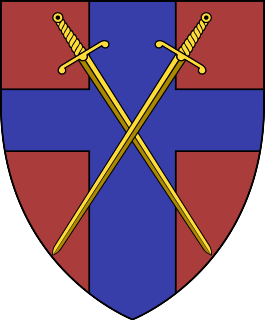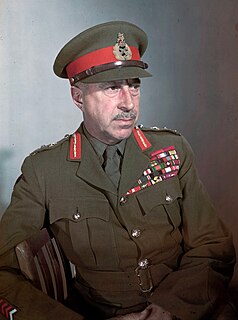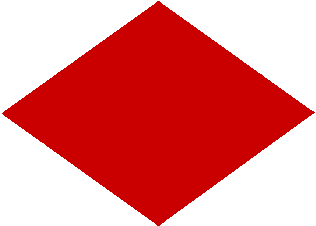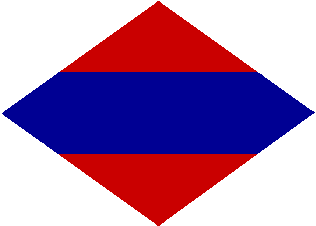
Field Marshal Bernard Law Montgomery, 1st Viscount Montgomery of Alamein,, nicknamed "Monty" and "The Spartan General", was a senior British Army officer who served in both the First World War and the Second World War.
The Conscription Crisis of 1944 was a political and military crisis following the introduction of forced military service for men in Canada during World War II. It was similar to the Conscription Crisis of 1917, but was not as politically damaging.

The 21st Army Group was a World War II British headquarters formation, in command of two field armies and other supporting units, consisting primarily of the British Second Army and the First Canadian Army. Established in London during July 1943, under the command of Supreme Headquarters Allied Expeditionary Force (SHAEF), it was assigned to Operation Overlord, the Western Allied invasion of Europe, and was an important Allied force in the European Theatre. At various times during its existence, the 21st Army Group had additional British, Canadian, American and Polish field armies or corps attached to it. The 21st Army Group operated in Northern France, Luxembourg, Belgium, the Netherlands and Germany from June 1944 until August 1945, when it was renamed the British Army of the Rhine (BAOR).

Events from the year 1944 in Canada.

The 52nd (Lowland) Infantry Division was an infantry division of the British Army that was originally formed as the Lowland Division, in 1908 as part of the Territorial Force. It later became the 52nd (Lowland) Division in 1915. The 52nd (Lowland) Division fought in the First World War before being disbanded, with the rest of the Territorial Force, in 1920.

The 2nd Canadian Division, an infantry division of the Canadian Army, was mobilized for war service on 1 September 1939 at the outset of World War II. Adopting the designation of the 2nd Canadian Infantry Division, it was initially composed of volunteers within brigades established along regional lines, though a halt in recruitment in the early months of the war caused a delay in the formation of brigade and divisional headquarters. With questions concerning overseas deployment resolved, the division's respective commands were formed in May and June 1940, and at British Prime Minister Winston Churchill's request, the division was deployed to the United Kingdom between 1 August and 25 December 1940, forming part of the Canadian Corps.

The Western Front was a military theatre of World War II encompassing Denmark, Norway, Luxembourg, Belgium, the Netherlands, the United Kingdom, France, Italy, and Germany. World War II military engagements in Southern Europe and elsewhere are generally considered as separate theatres. The Western Front was marked by two phases of large-scale combat operations. The first phase saw the capitulation of the Netherlands, Belgium, and France during May and June 1940 after their defeat in the Low Countries and the northern half of France, and continued into an air war between Germany and Britain that climaxed with the Battle of Britain. The second phase consisted of large-scale ground combat, which began in June 1944 with the Allied landings in Normandy and continued until the defeat of Germany in May 1945.

The 7th Medium Regiment, Royal Canadian Artillery, was one of six Canadian medium regiments that saw service in Britain and continental Europe in the Second World War, the others being the 1st, 2nd, 3rd, 4th, and 5th Medium Regiments. (There was no 6th Medium.)

The Allied advance from Paris to the Rhine, also known as the Siegfried Line campaign, was a phase in the Western European campaign of World War II.

General Henry Duncan Graham "Harry" Crerar was a senior officer of the Canadian Army who became the country's "leading field commander" in World War II, where he commanded the First Canadian Army.

The 79th Armoured Division was a specialist armoured division of the British Army created during World War II. The division was created as part of the preparations for the Normandy invasion on 6 June 1944, D-Day.

The Battle of the Scheldt in World War II was a series of military operations led by the First Canadian Army, with Canadian, Polish and British units attached, to open up the shipping route to Antwerp so that its port could be used to supply the Allies in north-west Europe. Under acting command of the First Canadian's Lieutenant-General Guy Simonds, the battle took place in northern Belgium and southwestern Netherlands from October 2 to November 8, 1944.

The Siege of Dunkirk, also known as the Second Battle of Dunkirk, during the Second World War, occurred from September 1944, when units of the Second Canadian Division surrounded the fortified city and port of Dunkirk. The siege by Allied forces lasted until after the official end of the war in Europe. German units within the fortress withstood probing attacks and as the opening of the port of Antwerp was more important, the 21st Army Group commander, Field Marshal Bernard Montgomery, decided to mask Dunkirk with the 1st Czechoslovak Armoured Brigade. The fortress, commanded by Admiral Friedrich Frisius, eventually surrendered unconditionally to Brigádní generál Alois Liška, the commander of the Czechoslovak brigade group, on 9 May 1945, two days after the surrender of Nazi Germany.

II Canadian Corps was a corps-level formation that, along with I (British) Corps and I Canadian Corps, comprised the First Canadian Army in Northwest Europe during World War II.

I Canadian Corps was one of the two corps fielded by the Canadian Army during the Second World War.
The 8th Reconnaissance Regiment , commonly abbreviated to 8 Recce, VIII Recce or 8 Canadian Recce, was the reconnaissance arm of the 2nd Canadian Infantry Division during World War II.

Clearing the Channel Coast was a World War II task undertaken by the First Canadian Army in August 1944, following the Allied Operation Overlord and the victory, break-out and pursuit from Normandy.

The First Canadian Army was a field army and a formation of the British Army in which most Canadian elements of the British Army serving in Northwest Europe were assigned. During the Second World War it served on the Western Front from July 1944 until May 1945.
This is a bibliography of works on the military history of Canada.
The 70th Infantry Division was a unit of the German Army during World War II. It was formed late in 1944 from personnel previously exempted from military service due to stomach disorders or injuries.















